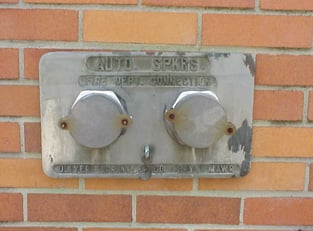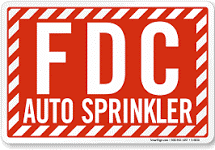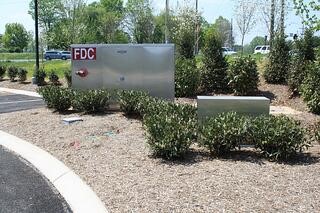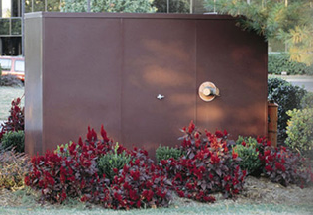 Water is the fundamental resource needed to battle a building fire. In urban areas where conventional street-side fire hydrants are few and far between, a rational solution long practiced has been to connect the sprinkler system within the building with exterior fire department connections. These fire department connections, or FDCs, are required by code to “be visible and recognizable from street or nearest fire department access, or on the street side of buildings (NFPA 14)”. They are designed to be easily accessible and highly visible so that firefighters can easily find them and connect their pump trucks to augment the sprinkler system with water and pressure to get the fire out as quickly as possible.
Water is the fundamental resource needed to battle a building fire. In urban areas where conventional street-side fire hydrants are few and far between, a rational solution long practiced has been to connect the sprinkler system within the building with exterior fire department connections. These fire department connections, or FDCs, are required by code to “be visible and recognizable from street or nearest fire department access, or on the street side of buildings (NFPA 14)”. They are designed to be easily accessible and highly visible so that firefighters can easily find them and connect their pump trucks to augment the sprinkler system with water and pressure to get the fire out as quickly as possible.
When the building is on fire, and the fire truck is flying down the street trying to find where to connect to the building’s sprinkler system, you want it to be easily found. However, architects and design engineers do not like big red FDC signs and large valves ruining their aesthetics, so they often put them behind bushes or stairwells to make them not quite as noticeable.
There is a better way: Municipalities across the U.S. have been combining the best practices of their cross-connection control programs with the best practices of locating their FDCs.
As you know, installing a backflow preventer above ground in a heated ASSE 1060 enclosure is the safest, most efficient and cost-effective method of protecting the water supply. Now, fire marshals are realizing that a well-located backflow enclosure is a perfect location for their FDC.
Improving Firefighter Safety
All across the country, from frigid western New York to moderate central Ohio to warmer northern Texas, forward-thinking cities are rewriting the rules for fire water resource location.
The best solution, one adopted by Flower Mound, TX, is to move the fire line backflow preventer to a location just beyond the right of way in an above-ground heated enclosure with an FDC mounted right to the side of the enclosure. The FDC is easily accessible and visible for the fire department to connect.
Many other cities have mimicked this best practice by mandating the fire line backflow preventer be located in this same location, essentially at the street. In late 2012, the city of Chicago recognized that protecting firefighters is central to any fire program. In October of that year, they amended their fire line installation guidance for all commercial properties with 50 feet or more of distance from the tap to the building to require that the fire line backflow preventer be located near the right of way in a heated, aboveground enclosure. Although the FDC is not mentioned in the code, officials recognize the enclosure as a perfect location for installation.
Like Chicago, other cities are adopting similar guidance creating an emerging trend for fire line installation. Charlotte, NC, and Lynchburg, VA, (see Page 15) are two examples where fire lines are now installed above ground in heated enclosures that meet the ASSE 1060 standards.
If you live in or know of a city that has adopted similar guidance please comment below. We are eager to remain fully informed about such changes.




